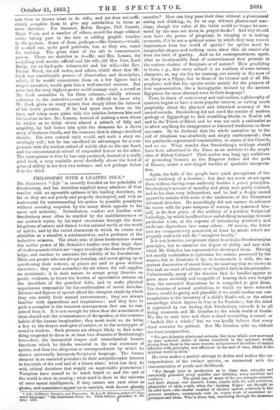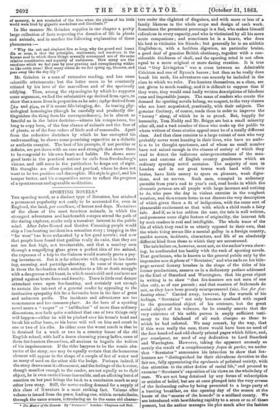PHILOSOPHY WITH A LEAPING POLE.*
GIUNDON'S "Life " is covertly founded on the principles of Swedenborg, and has doubtless supplied many admirers of that teacher with an agreeable epitome of his leading doctrines, so far as they are not purely and properly theological, and with an instrument for recommending his system to possible proselytes without arousing suspicion by too many direct appeals to his name and authority. Nevertheless, readers not familiar with Swedenborg must often be startled by the multifariousness of our author's topics, by his rapid excursions through the three kingdoms of nature, and thence to the rational world, or the world of spirits, and by the varied characters in which he courts our attention as a moralist, a sentimentalist, and a professor of the inductive sciences. The whole plan of these lucubrations shows the native power of Mr. Grindon's teacher over that large class of studious minds which are "eager to enlarge the domain of know- ledge, and careless to ascertain the solidity of its foundations." These are people who are always learning, and never giving up or questioning their notions, as plants are said to grow without excretion ; they must assimilate the air where the soil supplies no nutriment ; it is their nature to accept prosy theories on poetic evidence, to throw the burden of speculative science on the shoulders of the practical faith, and to make physical experiences responsible for the confirmation of moral doctrine. Dreams and figures of speech afford the cheapest staple by which they can satisfy their mental ravenousness ; they are always familiar with apparitions and inspirations ; and they love to push a metaphor to the remotest consequences that can be con- ceived from it. It is not enough for them that the association of ideas should suit the circumstances of the speaker, or the common habits of the human imagination ; they must insist on its being a key to the deeper analogies of nature, or to the archetypes of creative wisdom. Such persons are always likely to find some- thing congenial to them in at least two elements of Swedenborg's lore—first, the immaterial shapes and unmechanical human functions which he thinks essential to the real existence of spirits, and then the allegories or correspondences by which he almost universally interprets Scriptural language. The former element is an essential postulate to their antiphilosophic interest in the truth of the soul and of a future state; what can they do with ethical doctrines that supply no appreciable phenomena? Vampires have ceased to be much heard of, and the end of the world is slow in coming ; what need is there in the universe of mere moral intelligences, if they cannot see each other as ghosts, and sometimes appear so to mortals, with decent ghostly Life; its kature, TarieWe, and Phenomena. By Leo H. (Minden, author of " Figu- rative Language," "The Manchester Flora," do. Third Edition. (London F. Pit- man. 1855.
mantles ? How can they pass their time without a phantasmal eating and drinking, or, let us say, without phantasmal mar- riage, though the value of the latter could no longer be mea- sured by the uses set down in prayer-books ? And why should men have the power of pha,ptasy, in sleeping or in waking moments, if it be not a spiritual sense by which they may receive impressions from the world of spirits ? for spirits must be imaginable shapes and nothing more, since thin air cannot slip from the hold of gravity. And as for correspondences, again, what an inexhaustible fund of entertainment they promise to
the curious student of Scripture or of nature 1 How gratifying to learn, e. g., that every animal is an emblem of some human
character, as, say the fox for cunning, not merely in the eyes of an yEsoP or a Pilpay, but in those of its Creator and of all His prophets; and that the species exists mainly for the purpose of this representation, like a hieroglyphic devised by the ancient Egyptians for some abstract term in their language !
Then, in times of controversy and rationalism, a philosophy of symbols begins to have a more popular interest, as saving much perplexity about the physical and historical accuracy of the sacred records. Swedenborg did not need the results of modern geology or Egyptology to find stumbling-blocks in Noah's ark and in the Tower of Babel, and he was not such a rationalist as
to allow anything for exaggerated or distorted traditions in these accounts. So be declared that the whole narrative up to the call of Abraham was absolutely and simply emblematical ; that the patriarchs represented communities, or states of the Church, and so on. What wonder that Swedenborg's writings should have been advertised in the Times as an antidote to the scepti- cism of Bishop Colenso? Their author was long 'ago ambitious of protecting Genesis, as the Emperor Julian did the gods of Homer, under a new-forged buckler of symbolic interpreta- Again, the bulk of the people have quick perceptions of the moral tendency of a doctrine ; but dare not avow or act upon them without having some authority besides a priori principles.
Swedenborg's notions of morality and piety were partly rational, and in his time very independent, and ho had a deeply rooted quarrel to sustain with some of the tendencies of the Protestant
reformed churches. He accordingly did not venture to advance his views with the pure weapons of reason, but possessed him- self, in the first place, of the artillery of a peculiar Scriptural lexicology, by which he affixed new and striking meanings to some particular texts, at the expense of introducing platitudes and irrelevant digressions into many others. Of course, the latter
sort are comparatively unnoticed, at least by minds which are properly endowed with the "receptive faculty."
Ii is not, however, our present object to criticize Swedenborgian
principles, but to examine the degree of ability and tact with which Mr. Grindon has represented or developed them. Having not merely undertaken to epitomize the science possessed by his master, but to illustrate it by, or to reconcile it with, the im- portant discoveries of recent times, we must say that he shows in this task no want of boldness or of implicit faith in his principles. Unfortunately, many of the theories that he handles appear to grow more unwieldy and incapable of bearing their own weight from the extended dimensions he is compelled to give them. The doctrine of animal symbolism, to which we have referred above, would be pretty and plausible if we could confine our con- templations to the inventory of a child's Noah's ark, or the select assemblage which figures in Gay or La Fontaine ; but the mind is oppressed by our finding that Swedenborg extends it to all living creatures, and Mr. Grindon to the whole world of fossils. We like to note here and there a cloud resembling a camel, or "backed like a whale ;" but we can hardly believe that every cloud contains its portrait. But Mr. Grindon tells us, without the least compunction,
"The pre-Adamite plants and animals, like those which now surround us, were material shows of forms contained in the spiritual world, flowing from them in the same manner, and possessed therefore of similar affinities with principles and affections in the soul of man, which is the spiritual world in little."
He even makes a partial attempt to define and realize the cor- respondences of the extinct species, as connected with the characteristics of youth and childhood.
" For though later in production as to time, man virtually and essentially preceded every spinifer and trilobite, every coridline and conferva. . . . The great size of many of the pre-Aclamite animals, and their strange and uncouth forms, consist with the wild ambitious phantasies of early youth, when the Arabian Nights' are thought to be solid facts—the smaller number of distinct species, relatively to the present numbers, corresponds with its scanty stook of emotional ex- periences and ideas. Who is there that, wandering through the museums of memory, is not reminded of the time when the plains of his little world were trod by gigantic mastodons and dinotheria r
In like manner Mr. Grindon supplies in one chapter a pretty large collection of facts respecting the duration of life in plants and animals, and in another the following explanation of these phenomena :—
" Why the oak and elephant live so long, why the gourd and insect die so soon, is that the principles, sentiments, and emotions in the human soul to which these things severally correspond are of the same relative constitution and capacity of endurance. How many are the emotions which we feel year by year growing and strengthening within us like noble trees! How many others do we feel spring up, blossom, and pass away like the day-lily 1" Mr. Grindon is a man of extensive reading, and has some
scientific attainments ; but the latter seem to be constantly vitiated by his love of the marvellous and of the speciously edifying. Thus, among the etymologies by which he supports some argument, we find the substantive age derived from ague, to show that a man lives in proportion as he acts; zephyr derived from Cdr., and pips), as if it meant life-bringing, &c. In tracing phy- siological homologies (though he carefully and prudently dis- tinguishes the thing from his correspondences), he is almost as fanciful as in the latter doctrine—witness his comparisons, too long to copy here, of the four classes of animals and the four of of plants, or of the four orders of birds and of mammalia. Apart from the seductive doctrines by which he has corrupted his understanding, he shows some promising capacities as a didactic or resthetic essayist. The best of his precepts, if not peculiar or definite, are put down with an ease and strength that show them to be congenial to his own heart and habits. He shows some good taste in the practical notions he culls from Swedeuborg's visions, and still more in the particulars he keeps out of sight.
His thoughts are often quaint and poetical, where he does not want to be too positive and theosophic. His style is good, and his temper better, and his composition seems to reflect the progress of a spontaneous and agreeable meditation.































 Previous page
Previous page